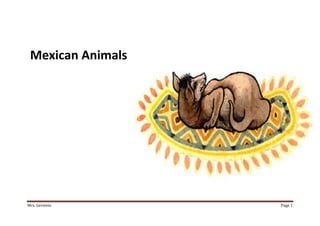
Mexican animals power point
- 1. Mexican Animals Mrs. Gerstein Page 1
- 2. The ancient Mexicans called Huitzitzilin (spine) the hummingbird because its peak is sharp, sharp. Hummingbirds buzz when they fly because they flap their wings as do bees and dragonflies. Mrs. Gerstein Page 2
- 3. The two most popular breeds of dogs or Mexicans were hairless bald, skin wrinkled, color ashen One of them, of medium size, is the Xoloitzcuintli, meaning monstrous dog. In ancient Mexico, the dog was called itzcuintli. Mrs. Gerstein Page 3
- 4. The other, called techichi, were small, short-legged. Born with hair, but after greasing the depilated turpentine ointment. The raised as pets and made them fat. Mrs. Gerstein Page 4
- 5. As the animal was more attached to family and loyal to his master, he sacrificed to the death of his master to accompany the soul of the deceased Mrs. Gerstein Page 5
- 6. It was assumed that this way you facilitated the difficult path to Mictlan or the world of the dead. Mrs. Gerstein Page 6
- 7. The New World monkeys, America, are flattened nose and are called new world monkeys. The Old World has a prominent nose, are called catarrhines. In Mexico we have two species of new world monkeys: howler monkeys and spider monkeys. Spider monkeys live in groups of 10 to 50 individuals led by the oldest. They inhabit the forests of the warmer regions. Mrs. Gerstein Page 7
- 8. The howler monkeys inhabit the same regions as the spider monkey. Are more robust and has reddish black fur on the belly and legs. Mrs. Gerstein Page 8
- 9. In Nahuatl legend of the four ages of the world is told that, because of the strong winds that destroyed everything, humans, trying to escape destruction, climbed trees and turned into monkeys. Mrs. Gerstein Page 9
- 10. Axolotl means water monster, because it is derived from two Mexican words: atl, water, and Xolotl monster. The axolotl is a strange animal: it never reaches its adult perfect. A few survive in the canals of Xochimilco and others in the depths of Lake Patzcuaro. Mrs. Gerstein Page 10
- 11. In the Nahuatl or Mexican language, says coatl snake. Coatl also means twin or twin.In Mexico there are about five hundred species of snakes. Only fifty are dangerous to man. Mrs. Gerstein Page 11
- 12. However, these animals appear to be important for agriculture and forest conservation, as when they are young eat insects, and when they are older eat rats, mice and gophers, plus chase the pests. Many farmers let boas live in their barns or barns to eat the rodents that destroy their crops. The meat is tasty boas, and many eat it. Mrs. Gerstein Page 12
- 13. Coatl was also the name of one of the Mexican calendar days. Mrs. Gerstein Page 13
- 14. Living things are a balanced, universal benefit concert for all, including men. Animals contribute to the preservation and growth of forests and all kinds of vegetation and agriculture. It is true that some insects are pests that eat leaves and fruit bite. Mrs. Gerstein Page 14
- 15. The animals, in turn, contribute to the preservation and growth of forests, pollinating flowers of many species, dispersing seeds and removing different kinds of pests. Mexican animals that we present, some very beautiful, some very strange, are all important. Mrs. Gerstein Page 15
- 16. Mrs. Gerstein Page 16
